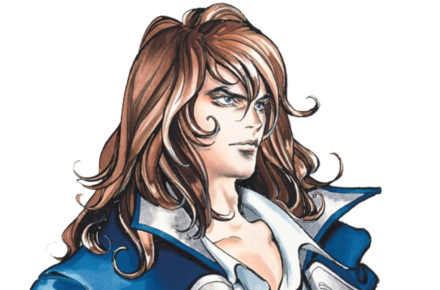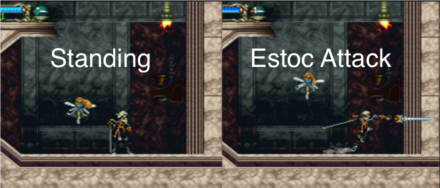The Complexities of Castlevania: SOTN – Standard Weapon Design Space and Variation
December 6th, 2017
[When developing Castlevania: Symphony of the Night, director Koji Igarashi wanted to make a game which would “overturn player’s ideas about Castlevania, yet also feel like a Castlevania game”. In pursuing this vision, his team made SOTN’s game system much more complex, incorporating RPG systems and a wide variety of nuanced player actions. This series of articles will examine how these additions shape SOTN’s core gameplay of moving through space to dodge and attack enemies.]
“Since we increased the size of the player character, we had to think about how that balance would work with the traditional whip; the problem is that the whip would reach across the entire screen, so we decided to make an action game based on other weapons instead”.
These “other weapons” form the foundation of SOTN’s combat system, defining the timing and spatial dynamics of each encounter as well as the player’s viable options. The weapon system provides the combat with a great deal of potential variety, but its sprawling and unregulated nature also clutter and fray the play experience.
The player can find around a hundred weapons scattered throughout Dracula’s castle and equip them as they please. The game organises the large number of arms into several groups: clubs, fists, shields, short swords, one-handed weapons, two-handed weapons, and throwing projectiles. By adjusting the variables below, the developers ensured that each weapon type occupy a unique functional position within the design space.
- Speed (how long it takes the attack hit box to enter its first frame)
- Range (the size of the hit box)
- Duration of attack (number of active hit box frames)
- Attack animation (the size, shape, and direction of the attack)
- Power (attack damage)
- Defence (for shields only)
- Additional properties
So short swords, one-handed weapons, and two-handed weapons represent the majority of arms and present the player with a reasonably clear choice between:
- Short swords: high speed, low/medium range, and low power
- One-handed weapons: medium speed, medium range, and medium power
- Two-handed weapons: low speed, high range, and high power, but no defence boost from shield
Shields allow the player to block attacks; and as the only equipable to offer this function, they play a distinct role in the design space. Similarly, throws have a unique range and travel arc which allow the player to attack from a distance. Clubs cover Alucard from the front and rear and do hit damage as opposed to cut damage (an additional attribute). Fists have a limited range, but a high speed. At close range, fists can perform double damage and from above Alucard can attack enemies beneath him.
“Each staff member had a special attachment to a different kind of blade, so we ended up with a good variety…”
Toshiharu Furukawa, SOTN designer
Each weapon within a group conforms to the same general properties, but occupies its own space within the category’s range. Furthermore, many weapons are imbued with additional attributes which facilitate more nuanced playstyles and contribute to a more varied and wrinkly combat system. The three examples below demonstrate the implications that weapon choice has on gameplay.
The Estoc is a giant German two-handed sword with a strong attack, huge hit box, and long attack duration. These strengths are balanced out by several significant drawbacks:
- The sword is so large that when Alucard strikes, he lunges forward.
- The attack takes some time to start up.
- The attack leaves a large, exposed gap where ground enemies can slip through. The player can’t counter by crouching as attacking with the Estoc forces Alucard into a standing state.
Together these weaknesses make it impossible to attack half-height ground enemies, unless the castle architecture allows Alucard to approach from below (for example, on a staircase). This gaping blindspot encourages the player to develop new ways of engaging these foes.
Despite belonging to the same weapon category, Nunchakus (a pair of wooden hand batons) are completely different from the Estoc. They have weak attack, a small hit box, and a short attack duration. A fast start up time and a second follow through attack that occurs soon after the initial strike offset these cons. Although Alucard can attack quite quickly with the Nunchakus, he needs to be closer to his enemies to land the full attack, which puts him at greater risk. Thus, a Nunchakus wielder would need to have a greater consciousness of enemy openings and be able to develop strategies for sweeping in and out of enemy range.
The Icebrand and Mormegil are almost identical except for their elemental attributes. The Icebrand, being an ice elemental weapon, does extra damage against fire enemies, but heals ice enemies. The Mormegil, being a dark elemental weapon, does extra damage against holy enemies, but heals dark enemies. Depending on the given situation, the effectiveness of either weapon differs. So these two weapons encourage an awareness of enemy elementals and stress player knowledge.
“…though this did result in the developers’ favourite weapons being super-powered. Not realising that no one liked shields was a bit of a blind spot…”
Toshiharu Furukawa, SOTN designer
As the second half of Furukawa’s comment denotes, SOTN’s complex weapon design space suffers from a number of blemishes which significantly impeed the gameplay.
Weapons not conforming to type
Although Nunchakus and the Estoc belong to the same weapon class, they facilitate completely different combat dynamics. Wielding Nunchakus involve dealing with enemies at close range (higher reaction and adaption skills), while the Estoc prompts the player to compensate for a gaping blind spot (more strategic, planned attacks). Nunchakus function more like fists than a heavy two-handed weapon. Weapons like Nunchakus (which are in no small number) therefore blur the clear separation between categories, which makes it more difficult for players to rely on the weapon categorisation to make informed decisions over weapon choice.
The Shotel, Combat Knife, and Basilard similarly betray the definition of a short sword. The Shotel has a medium range, the Combat Knife has a shorter range, and the Basilard has an even shorter range still, even though the game classes them all as short swords.
Too nuanced to be applicable for average players
As with the high jump and air kick, some weapon properties are too slight or nuanced to be functionally viable for your average player. For example, certain weapons have elemental attributes (such as Icebrand and Mormegil) or are sharp (swords) or blunt (clubs). Weapons with these particular properties work well against some enemies, but not against others. However, effectively exploiting these details in combat hinges on some unrealistic expectations:
- the player will be able to identify an enemy’s weakness through its appearance, even though the form-function relationship in SOTN is quite inconsistent. For example, some skeletons are weak against holy, but others aren’t. (Browse through the game’s bestiary for more examples).
- the player will pause the game to switch to the most effective weapon
- the player will know which weapon (out of a maximum of 90ish) has the required elemental attribute for the situation or will be willing to wade through their weapon list to find out
As for how many weapon attributes are too slight or nuanced, I find it hard to draw a clear line. I also haven’t tried out all of the weapons myself, so I’m not exactly sure. You’re welcome to judge for yourself though. This weapon list shows each weapon’s special attributes.
Weapons as progress indicators lead to clutter
Despite the significant array of choice on offer, most weapons conform to its category’s base speed, range, duration of attack, and attack animation properties, with the key differentiator being power. So as Alucard progresses through the castle, he stumbles upon similar weapons with increasingly higher power stats. The idea being that weapon power creates a sense of character development as the damage numbers go up. However, using weapons as a barometer for progress like this adds an excessive number of functionally similar items to the player’s inventory. Regardless of the fact that weapon specialties are perhaps too nuanced for most players, the paralysing effect of having so many choices in one’s inventory only makes it harder for players to realise the versatility on offer.
Conclusion
SOTN’s arsenal of weapons provides a rich design space which focuses the player on various facets of the game’s combat design (for example, close combat, agile but weak attacks, and elemental strikes). The weapon classes provide reasonably clear distinctions and help players organise their preferences. The variation works on a functional level because the properties of weapon size, length, hitboxes, and animation are grounded in the dynamics of time and space.
However, complexities relating to more abstract attributes (such as elemental and sharp/blunt indicators) sit outside of the average player’s reach. Also, some weapons function more closely to weapons outside of their designated type. These anomalies fray the distinctions of choice within the game. The overwhelming number of weapons on offer (for the sake of facilitating player progress) also swamp the design space, which makes it harder for unique options to stand out. One can’t help but think that 30 more functionally distinct weapons would be easier for players to manage than 90 reasonably similar weapons. So much like the traversal mechanics, the weapons suffer from unrefined details in the game’s design.





 Game Design Companion: A Critical Analysis of Wario Land 4 - $7.99
Game Design Companion: A Critical Analysis of Wario Land 4 - $7.99 Level Design: Processes and Experiences
Level Design: Processes and Experiences Speed Boost: The Hidden Secrets Behind Arcade Racing Design - $5.99
Speed Boost: The Hidden Secrets Behind Arcade Racing Design - $5.99 Adventures in Games Analysis: Volume I - $5.99
Adventures in Games Analysis: Volume I - $5.99







